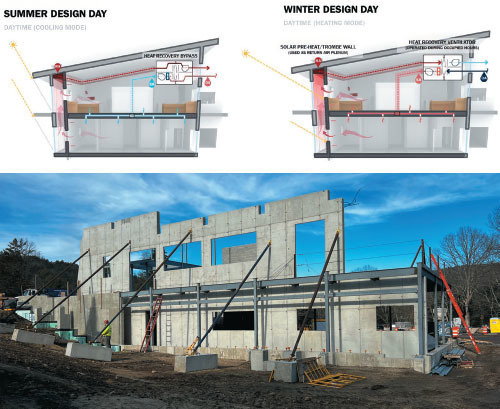Beyond the bottle
Exploring other end markets for recycled glass. When people think ......

In recent years, there has been a push in architecture to design and construct buildings that have a lower carbon footprint. This trend is driven by the real need to address the global challenge of climate change and the recognition that buildings are significant contributors to greenhouse gas emissions. There are several strategies for constructing projects that help meet carbon reduction goals.
Designing energy efficient buildings that are resistant to natural disasters can significantly reduce life-cycle carbon emissions of a building. But another key strategy involves choosing sustainable building materials that have a lower carbon footprint. With new innovations and technologies, concrete is one material that is proving it has the potential to support these reduction goals.
In Connecticut, one state agency is embracing the challenge of climate change mitigation. The Connecticut Department of Energy and Environmental Protection (DEEP) is tasked with mitigating negative energy and environmental impacts, and so it makes perfect sense that the agency should demonstrate its own mission. DEEP’s new Western District Headquarters at Black Rock State Park located in Watertown is the first net-zero and LEED Platinum building built by the state.

The building is the result of several years of planning. It allows the agency to consolidate staff from nine outdated buildings that have been, until now, located in five separate towns. Combining them into one building will save energy and money, and it will increase efficiency. The new main building will be designed to achieve LEED Platinum certification and net-zero energy standards. A fully integrated approach to building systems and assemblies was required to maximize efficiency even more and minimize environmental impacts. It became clear to the building’s designers that a thermal mass wall would optimize the site’s solar orientation to reduce overall energy consumption. A Trombe wall was designed to provide passive heating during the winter months, passive cooling during the summer and improved natural ventilation.
With the combination of earth sheltering, photovoltaics, a geothermal system, radiant polished concrete slabs and a carefully designed building envelope, the building’s energy consumption will be significantly lower than a comparably sized traditional building. It will result in a 30-40% reduction in energy consumption when compared to a building designed to current building and energy codes. The building will be finished with wood grown from Connecticut state forests and milled at DEEP’s sawmill.
The use of innovative concrete in this project is key to reducing the embodied carbon footprint of the project. Concrete is a durable building material that provides environmental benefits due to its longevity. But its environmental impact can be reduced with new technologies. Traditional cement used in concrete accounts for roughly 88% of its emissions, which means replacing traditional portland cement with alternative materials can have a big impact.

To reduce the carbon footprint of the DEEP facility, the plans call for 40% cement replacement in the structural concrete mixes with a high-quality ground-glass pozzolan – a supplementary cementitious material (SCM) made from 100% recycled post-consumer glass. For this project, the pozzolan was evaluated to determine its effectiveness, availability and carbon reduction potential. A variety of mixes were evaluated to make up the 40%. The ground-glass pozzolan product for this project is considered a safe, sustainable and high-performing pozzolan that dramatically reduces embodied CO2 emissions in concrete.
This ground-glass pozzolan was manufactured with 100% post-consumer glass sourced within a 50-mile radius and manufactured in Connecticut, just 16 miles from the site. The local sourcing and manufacturing also help reduce embodied carbon by way of reducing transportation. This pozzolan contains no crystalline silica, heavy metals or known carcinogens, making it a non-toxic material. Independent testing of the product shows it at 56kg CO2e in comparison to the average GWP for portland cement of 922 kg CO2e, resulting in 94% less impact. The new headquarters aligns with the state’s goals to mitigate the climate crisis with an effort by state government to lead by example and identify opportunities for savings and ways to make government operations more sustainable.
The concrete sector is continually seeking innovations, including blended cements, supplementary cementitious materials (SCMs), admixtures and other technologies to help make durable, sustainable and cutting-edge designs, such as the DEEP headquarters. NRMCA’s Concrete Innovations Learning Center digs deeper into the history, performance and benefits of innovative products such as ground-glass pozzolans, natural pozzolans and limestone calcined clay cements, biochar and harvested fly ash among many others.Through this process, the concrete sector is exploring how innovation of a 5,000-year-old technology can help achieve carbon reduction goals.
Exploring other end markets for recycled glass. When people think ......
HARTFORD–U.S. Senator Chris Murphy (D-Conn.) announced that Urban ......